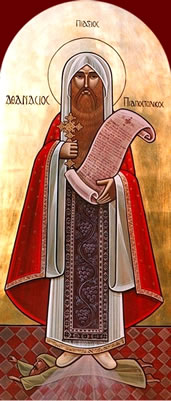Philostorgius’ record of those who sympathized with Arius II
| Date | c. 1210 |
| Ancient source | Nicetas Choniates’ Treasury of Orthodoxy 5.7 Nicetas was a lawyer in Constantinople in 1204 when the city was taken by the crusaders. Besides many other interesting and historically important works he wrote this Treasury of Orthodoxy. Portions of this work are published in Migne, PG, vol. 139, col. 1093 – vol. 140, col. 292, but the entire work has never been published, though it exists in manuscript form. |
| Modern edition used | F. Winkelmann (post J. Bidez), Philostorgius. Kirchengeschichte, 3rd edn. Die griechischen christlichen Schriftsteller (Berlin: Akademie Verlag, 1981), p. 9. This is an edition of Philostorgius, but it includes brief quotations from other works, including Nicetas. |
Philostorgius says in the first book of his history that those who were Arian-minded bishops in the region of Libya were: Sentianus of Boreion, Dachius of Beronice, Secundus of Tauchira, Zopyrus of Barce, the other Secundus of Ptolemais,1 Theonas of Marmarice;
from Thebaid of Egypt: Melitius;
from Palestine: Patrophilus of Scythopolis, Eusebius of Caesarea, called Pamphilus;
from Phoenicia: Paulinus of Tyre, Amphion of Sidon;2
from Cilicia: Narcissus of Irenopolis, Athanasius of Anazarbos, Tarcondimatus of Aegeai;
from Cappadocia: Leontius, Longianus, and Eulalius;
from Pontus: Basil of Amasea,3 Melitius of Sebastopolis;
from Bithynia: Theognis of Nicaea, Maris of Chalcedon, Eusebius of Nicomedia, who is called The Great, a disciple of Lucian the martyr, whose distinction is acknowledged by all, which is why he received the name “Great.”
References for Map of Early Arian Supporters:
| Philostorgius I | Philostorgius II | Theodoret | Arius’ letter |
Translation and introduction by AJW
- According to Theodoret, this Secundus was bishop of Ptolemais in Egypt, unless there were two men named from Secundus from different cities named Ptolemais.
- Williams places him in Cappadocia, and suggests emending the text to read “Amphion of Epiphanea”, who signed the Nicene Creed. See Williams, 67-68, quoted in Parvis, p. 43, notes 24 and 25 (see bibliography).
- Basil of Amasea was martyred in 312, according to Ernst Honigmann, Patristic Studies, Studi e Testi 173 (Vatican City: Biblioteca Apostolica Vaticana, 1953), pp. 14-27, cited in Parvis, p. 44, note 28. This fact leads Parvis to the conclusion that this list was only a list of those who “had some theological sympathy with Arius prior to late 324” but that either Philostorgius or Nicetas associated it with Nicaea (p. 45).
No Responses yet
